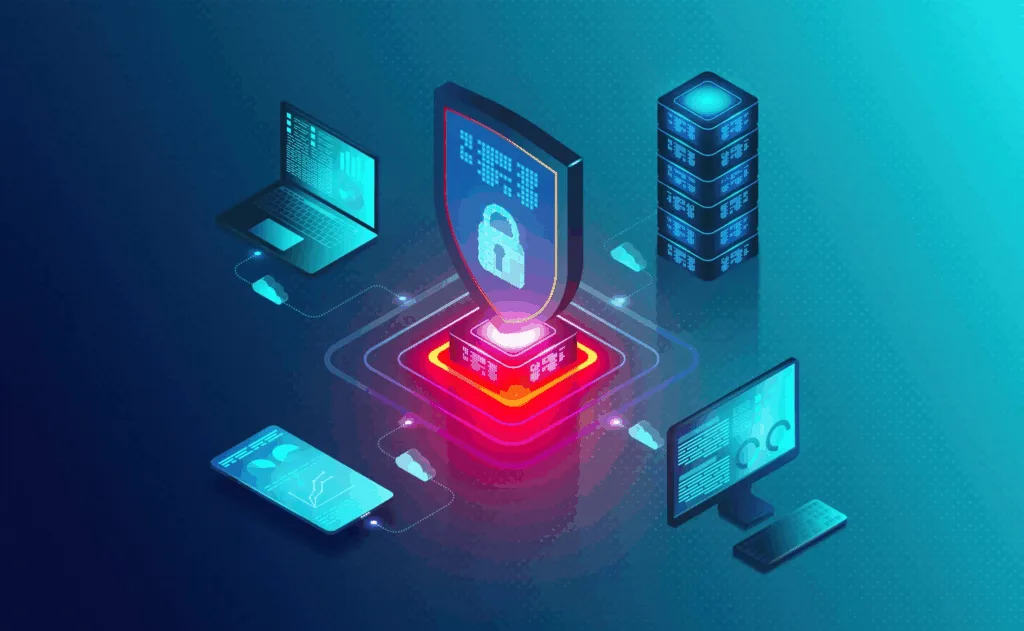
Every piece of data you send—whether it’s an email or a bank login—travels across networks that are constantly under attack. Most of the time, you won’t notice anything is wrong until it’s too late. But when a breach does happen, the damage is immediate. Ransomware halts operations, personal data gets dumped online, and sensitive information is stolen.
So why does this keep happening? And more importantly—how do you stop it?
In this guide, we’ll break down what network security is, how it works, and the ways attackers manage to bypass it. Because the first step to securing a network is understanding how it gets breached in the first place.
What is Network Security?

At its core, network security is about control.
It determines:
- Who can connect
- What they can access
- And how to detect suspicious activity before it escalates into a full-scale breach
That means blocking malicious traffic, encrypting sensitive data, isolating internal systems, and keeping watch over everything moving across the network. Why so thorough? Because it takes only one overlooked device or weak spot to compromise an entire system.
How Network Security Works?
Network security isn’t a single tool or setting—it’s a layered system. Each layer is designed to block threats, limit their movement if they get in, or detect them before they can cause serious harm. If one layer fails, the others are there to catch what slips through.
Let’s go through each layer, see how it works, and explore the common attacks—and defenses—at every stage.
Layer 1: Perimeter Controls
Every network security needs a first line of defense—something that decides who can come in, what they can do, and who gets turned away. These perimeter controls are like security guards at the front gate, inspecting every request and deciding what’s allowed in.
This usually starts with firewalls, which monitor traffic entering and leaving your network. They can block unused ports, deny suspicious IP addresses, and reject connections that don’t match expected patterns. Routers play a role too, forwarding traffic and enforcing rules based on its origin, destination, or protocol.
Sounds simple—but if this layer is misconfigured, attackers don’t need to “break in.” They can just walk right through the front door.
How Hackers Get Through
Most cyberattacks are crimes of opportunity—the digital equivalent of finding an unlocked car with the keys inside.
Sometimes, it’s as easy as discovering a forgotten test server, an outdated login page, or even an unsecured IoT device like a fish tank thermometer. Attackers use tools like Shodan, Censys, and Nmap to scan the internet for exposed services such as RDP, SSH, database ports, or admin dashboards still using default credentials.
One real-world example: hackers found an exposed VPN account with no multi-factor authentication and no rate limits—essentially a front door with no lock.
How to Defend It
These aren’t theoretical risks—they’re exactly what you learn about in offensive security. The fix starts with removing the opportunities attackers rely on.
For strong perimeter security:
- Block unused ports and services
- Never expose login panels or admin tools directly to the internet
- Use VPNs or zero-trust access for remote connections
- Require MFA on all external access points
- Place public-facing services in a DMZ so they can’t reach internal systems
- Regularly scan your own network security externally, using the same tools attackers do
The goal isn’t to make the network security invisible, but to ensure anything that’s visible is there intentionally, is locked down, and is being monitored.
If you’ve never run your own scans with Shodan or Nmap, you might be surprised at what’s exposed—and once you see it from the attacker’s perspective, you’ll never look at your firewall the same way again.
Layer 2: Access Control
If perimeter controls decide who gets in, access control determines what they can do once inside. This isn’t just for security—it prevents accidents, like an intern unintentionally deleting critical files.
At its core, access control is about boundaries:
- Can this account access sensitive systems?
- Should this device communicate with that server?
- Does this user need admin rights at all?
When implemented well, access control minimizes the damage a breach can cause. Unfortunately, many networks operate under the flawed assumption that “if it’s inside, it’s safe.”
How Hackers Exploit It
Weak internal security habits make access control a prime target.
Take the casino fish tank hack—the thermometer was on the main network security. Once attackers breached that IoT device, nothing stopped them from reaching a sensitive database.
Common breakdowns include:
- Saved credentials in browsers or config files, ready for the taking
- Credential reuse, where the same email/password combo is used for work and a breached third-party site
- Shared admin accounts that give one compromised user full system access
- Poor segmentation, allowing unrelated devices to communicate, like a marketing laptop talking to a database server
In many cases, attackers don’t need to exploit a technical vulnerability—a phishing email or default password is enough to gain access and move laterally through the network security.
How to Defend It
Strong access control means treating every internal connection as untrusted until proven otherwise.
Best practices include:
- Implementing role-based access control (RBAC) so users only have the permissions they need
- Segmenting networks with VLANs or subnets to isolate internal systems
- Enforcing MFA everywhere, not just for external logins
- Reviewing and revoking old or unused accounts regularly
- Using network ACLs to define exactly which systems can communicate
The fewer paths an attacker can take, the easier it is to detect and stop them. Ideally, even if they gain access, they’ll find nothing they can use.
Layer 3: Encryption
One of the first things an attacker will check is whether your network security traffic is encrypted. If it isn’t, they can see everything.
For example, if someone logs into a site using plain HTTP or transfers files with outdated protocols like FTP or Telnet, anyone on the same network security can intercept and read that data instantly. They don’t need advanced tools—free software like Wireshark can capture usernames, passwords, session cookies, or even full documents as they travel.
Encryption prevents this by protecting data in transit. Without it, anything sent over the wire is vulnerable.
Modern networks rely on:
- TLS/SSL to secure websites, email, APIs, and file transfers
- VPN tunnels to protect remote workers on untrusted networks
- End-to-end encryption for apps that exchange sensitive data
How attackers exploit weak encryption (and how to stop them)
Encryption alone isn’t enough—it must be properly implemented. A common weakness is fallback. If a certificate is expired or misconfigured, many systems quietly downgrade to an unencrypted connection, giving attackers a chance to strip encryption completely. Tools like sslstrip are built for this.
Prevent it by enforcing HTTPS across all services and enabling HTTP Strict Transport Security (HSTS). Regularly audit certificates to catch expired, mismatched, or weak configurations, especially on public-facing systems.
Legacy protocols are another risk. If your environment still supports SSLv2, TLS 1.0, or outdated cipher suites, attackers can force downgrades to break encryption. Disable these entirely and test with services like Qualys SSL Labs.
And if you still run services like FTP, Telnet, or POP3? Those send everything in plain text—one legacy service can compromise your whole network. Replace them with secure alternatives or shut them down.
There’s also a human factor: many users click through certificate warnings without realizing the risk, often handing credentials to fake sites over HTTP. Combat this with strict certificate validation, domain monitoring, and user training on the meaning of certificate errors.
Layer 4: Monitoring
If an attacker gains access, the length of time they remain and the damage they cause depends on how quickly they’re detected—this is where monitoring tools come in. They won’t block attacks directly, but they can alert you to suspicious activity.
Attackers rarely move fast. Instead, they blend in, using tools like PowerShell, WMI, certutil, and scheduled tasks to quietly scan systems, escalate privileges, and establish long-term access. They often set up a command and control (C2) channel to manage the breach remotely. In real-world attacks, stealth C2 frameworks such as Cobalt Strike, Sliver, Mythic, or Metasploit’s Meterpreter are common. These disguise traffic with encryption, randomized beacons, and legitimate protocols like HTTPS or DNS.
How to defend:
Effective monitoring means detecting unusual patterns and connecting anomalies that don’t fit normal behavior. This requires a combination of:
- SIEMs (Security Information and Event Management) to correlate logs from firewalls, endpoints, servers, and cloud tools, alerting on patterns that suggest attacks.
- NIDS (Network Intrusion Detection Systems) to inspect traffic for known attack signatures, from port scans to beacon traffic.
- Anomaly detection to flag deviations from normal activity, such as unexpected internal scans, off-hours scheduled tasks, or unusual outbound DNS queries.
For example, if a compromised laptop runs BloodHound to map the network, uses Mimikatz to dump credentials, and launches a PowerShell pivot, monitoring can detect these signs—giving you a window to act before serious damage occurs.
Layer 5: Incident Response
This is the layer you hope to never need, but when a breach occurs, it’s the one that matters most. Even with strong defenses, someone will eventually get through. When that happens, every second counts.
Incident response is your structured plan for containing threats, investigating incidents, and preventing further damage. Many organizations neglect this step, focusing only on prevention—leaving them unprepared and slow to act when a real attack happens.
A strong response plan includes:
- Rapidly isolating affected systems
- Identifying which accounts, data, or systems were accessed
- Resetting passwords, revoking session tokens or API keys
- Fixing the exploit so it can’t be reused
- Restoring systems from clean backups
- Documenting the incident and notifying relevant stakeholders or regulators
- Reporting breaches to authorities if required
Example: Monitoring flags unusual outbound traffic from a server. You isolate it and discover scheduled tasks uploading data to Dropbox—a live exfiltration. Without a plan, hesitation could mean losing critical evidence. With a plan, you know exactly what to shut down, what to review, and who to alert.
Final Word: Network Security Isn’t Optional
All it takes is one exposed port or a misconfigured access rule to compromise an entire network. Security must be intentional, layered, and constantly maintained—because “hoping nothing goes wrong” isn’t a strategy. The time to build real defenses isn’t someday—it’s now.

